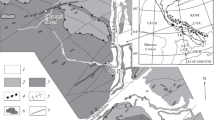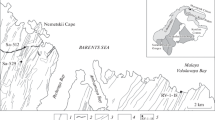Abstract
Gabbro-dolerite dikes were studied in the junction zone between two structures of different ages of the Fennoscandian shield: the Archean Fenno-Karelian craton and the Raakhe–Ladoga zone. Their composition was analyzed and U-Pb baddeleyite and zircon age was determined for the first time for the Russian territory. The Paleoproterozoic age has been established both for the gabbroic rocks of the Fenno-Karelian craton (previously considered Archean) and for the gabbro-dolerites of the Raakhe–Ladoga zone. The dike swarms within the Fenno-Karelian craton were formed in two stages: within 2091 ± 9–2086 ± 6 Ma near the Raakhe–Ladoga zone and in the central part of the studied area and within 1938 ± 6–1933 ± 26 Ma in the northern part. Sills of the Raakhe–Ladoga zone (2081 ± 7 Ma) were formed simultaneously with the earlier dikes of the Fenno-Karelian Craton (2091 ± 9–2086 ± 6 Ma). Primary magmas were derived from different sources. Most of the bodies of the Fenno-Karelian craton have high (La/Lu)N, negative niobium anomalies, predominantly negative εNd values, which suggests a contribution of a metasomatized lithospheric mantle. Some dikes of the Raakhe–Ladoga zone have the same source, but most rocks were obtained by mixing of depleted mantle and more primitive mantle source. The studied gabbrodolerite dikes were likely formed in a rifting tectonic setting.















Similar content being viewed by others
REFERENCES
V. Beckman, C. Moller, U. Söderlund, and J. Andersson, “Zircon growth during progressive recrystallization of gabbro to garnet amphibolite, eastern segment, Sveconorwegian Orogen,” J. Petrology 58 (1), 167–188 (2017).
L. P. Blask, S. L. Kamo, C. M. Alen, J. N. Aleinikoff, D. W. Davis, R. J. Korsch, and C. Foudoulis, “TEMORA 1: a new zircon standard for U-Pb geochronology,” Chem. Geol. 200 (1–2), 155–170 (2003).
K. C. Condie, “Sources of Proterozoic mafic dyke swarms: constraints from Th/Ta and La/Yb ratios,” Precambrian Res. 81, 3–14 (1997).
K. C. Condie, “High field strength element ratios in Archean basalts: a window to evolving sources of mantle plumes?” Lithos 79, 491–504 (2005).
J. G. Fitton, A. D. Saunders, L. M. Larsen, M. S. Fram, A. Demant, and C. Sinton, “Magma sources and plumbing systems during break-up of the SE Greenland margin: preliminary results from ODP Leg 152,” J. Geol. Soc. 152, 985–990 (1995).
S. J. Goldstein and S. B. Jacobsen, “Nd and Sr isotopic systematics of rivers water suspended material: implications for crustal evolution,” Earth Planet. Sci. Lett. 87, 249–265 (1988).
A. F. Grachev, “Identification of mantle plumes based on studying the composition of volcanic rocks and their isotopic–geochemical characteristics,” Petrology 11 (6), 562–596 (2003).
P. W. O. Hoskin and Urs. Schaltegger, “The composition of zircon and igneous and metamorphic petrogenesis,” Rev. Mineral. Geochem. 53 (1), 27–62 (2003).
T. N. Irvine and W. R. A. Baragar, “A guide to the chemical classification of the common volcanic rocks,” Can. J. Earth Sci. 8, 523–548 (1971).
S. B. Jacobsen and G. J. Wasserburg, “Sm-Nd evolution of chondrites and achondrites,” Earth Planet. Sci. Lett. 67, 137–150 (1984).
A. Kontinen, “An early Proterozoic ophiolite – the Jormua mafic–ultramafic complex, Northeastern Finland,” Precambrian Res. 35, 313–341 (1987).
Yu. A. Kostitsyn, “Terrestrial and chondritic Sm–Nd and Lu–Hf isotopic systems: are they identical?” Petrology 12 (5), 397–411 (2004).
Proterozoic Ladoga Structure: Geology, Deep Structure, and Metallogeny (KarNTs, Petrozavodsk, RAN, 2020) [in Russian]. K. P. Ludwig, “SQUID 1. 00. A user’s manual,” Berkeley Geochronol. Center. Spec. Publ., No. 2, (2000).
K. P. Ludwig, “Isoplot/Ex. A user’s manual,” Berkeley Geochronol. Center. Spec. Publ., No. 1 (2001).
M. V. Malashin, A. I. Golubev, V. V. Ivanikov, and N. B. Filippov, “Geochemistry and petrology of the Lower Proterozoic mafic volcanic complexes of Karelia: I. Jatulian trap complex,” Vestn. SPBGU, Ser. 7, 1 (7), 3–32 (2003).
T. A. Myskova and P. A. Lvov, “Supracrustal rocks of uneven-aged Archean Greenstone structures of the Karelian Craton of the Fennoscandian Shield at the border with the Svecofennian Block: composition, age, and origin,” Stratigraphy. Geol. Correlation 30 (1), 1–29 (2022).
H. E. O’Brien, H. Huhma, and P. Sorjonen-Ward, “Petrogenesis of the late Archean Hattu schist belt, Ilomantsi, eastern Finland: geochemistry and Sr, Nd isotopic composition,” Geol. Surv. Finland, Spec. Pap. 17, 147–184 (1993).
Early Precambrian of the Baltic Shield (Nauka, St. Petersburg, 2005).
Resolution of the Third All-Russian Meeting “General problems of Precambrian stratigraphy,” Stratigraphy. Geol. Correlation 9 (3), 304–308 (2001).
P. Richard, N. Shimizu, and C. J. Allegre, “143Nd/144Nd a natural tracer: An application to oceanic basalts,” Earth Planet. Sci. Lett. 31, 269–278 (1976).
N. V. Rodionov, B. V. Belyatsky, A. V. Antonov, I. N. Kapitonov, and S. A. Sergeev, “Comparative in-situ U–Th–Pb geochronology and trace element composition of baddeleyite and low-U zircon from carbonatites of the Palaeozoic Kovdor alkaline–ultramafic complex, Kola Peninsula, Russia,” Gondwana Res. 21, 728–744 (2012).
D. Rubatto and M. Scambelluri, “U-Pb dating of magmatic zircon and metamorphic baddeleyite in the Ligurian eclogites (Voltri Massif, Western Alps),” Contrib Mineral Petrol. 146, 341–355 (2003).
J. G. Schilling, R. H. Kingsley, B. B. Hanan, and B. L. McCully, “Nd–Sr–Pb isotopic variations along the Gulf of Aden: Evidence for Afar mantle plume–continental lithosphere interaction,” J. Geophys. Res. 97, 10927–10966 (1992).
M. A. Semikhatov, “New Precambrian stratigraphic scale: a comparison,” Stratigrafiya. Geol. Korrelyatsiya 1 (1), 6–20 (1993).
L. N. Sharpenok, A. E. Kostin, and E. A. Kukharenko, “TAS-diagram of total alkalis–silica for the chemical classification and identification of plutonic rocks,” Regional. Geol. Metallogen. 56, 40–50 (2013).
S. G. Skublov, A. O. Krasotkina, A. B. Makeev, O. L. Galankina, and A. E. Melnik, “Unique find of zircon transformation in baddeleyite: Ichet’yu occurrence, Middle Timan,” Izv. Vyssh. Ucheb. Zaved., Geol. Razved., no. 1, 27–35 (2018).
U. Söderlund and L. Johansson, “A simple way to extract baddeleyite (ZrO2),” Geochem. Geophys. Geosyst. 3 (2), 1–7 (2002).
State Geological Map of Russian Federation on a Scale 1 : 1 000 000 (Third Generation). Baltiiskaya Series. Sheets P–(35), 36 – Petrozavodsk. Explanatory Note (Kartograficheskaya fabrika VSEGEI, St. Petersburg, 2015) [in Russian].
A. V. Stepanova, A. V. Samsonov, E. B. Salnikova, I. S. Puchtel, Yu. O. Larionova, A. N. Larionov, V. S. Stepanov, Y. B. Shapovalov, and S. V. Egorova, “Paleoproterozoic continental MORB-type tholeiites in the Karelian Craton: petrology, geochronology, and tectonic setting,” J. Petrol. 55, 1719–1751 (2014).
A. V. Stepanova, E. B. Salnikova, A. V. Samsonov, S. V. Egorova, Yu. O. Larionova, and V. S. Stepanov, “The 2.31 Ga mafic dykes in the Karelian Craton, eastern Fennoscandian shield: U–Pb age, source characteristics andimplications for continental break-up processes,” Precambrian Res. 259, 43–57 (2015).
A. V. Stepanova, E. B. Salnikova, A. V. Samsonov, Yu. O. Larionova, S. V. Egorova, and V. M. Savatenkov, “The 2405 Ma doleritic dykes in the Karelian Craton: a fragment of a Paleoproterozoic large igneous province,” Dokl. Earth Sci. 472 (1), 72–77 (2017).
A. V. Stepanova, A. N. Larionov, and Yu. O. Larionova, “2.2-Ga sills in the central part of the Karelian Craton: U-Pb zircon geochronology and geochemistry of gabbro-dolerites of the Bol’shozero area,” Tr. KarNTs RAN. Ser. Geol. Dokembriya 11, 3–16 (2018).
S. S. Sun and W. F. McDonough, “Chemical and isotopic systematics of oceanic basalts: implications for mantle composition and processes,” Geol. Soc. London Spec. Publ. 42, 313–345 (1989).
L. P. Sviridenko, E. V. Isanina, and N. V. Sharov, “Deep structure, volcanoplutonism, and tectonics of the Ladoga region,” Tr. Karelsk. Nauchn. Ts. RAN, no. 2, 73–85 (2017).
V. I. Vinogradov, “Implications of model Sm–Nd age for the Earth’s geological history interpretation,” Geotectonics 38 (1), 72–77 (2004).
J. Vuollo and H. Huhma, “Precambrian geology of Finland: key to the evolution of the Fennoscandian Shield,” Precambrian Geol. 14, 195–236 (2005).
D. L. Whitney and B. W. Evans, “Abbreviations for names of rock-forming minerals,” Am. Mineral. 95, 185–187 (2010).
I. S. Williams, “U-Th-Pb geochronology by ion microprobe,” Application of Microanalytical Techniques to Understanding Mineralizing Processes, Ed. by M. A. McKibben, W. S. Shanks III, and W. I. Ridley, Rev. Econ. Geol. 7, 1–35 (1998).
Funding
This work was made in the framework of the government-financed project no. FMUW-2022-0004. U-Pb dating of accessory minerals was performed in the framework of the experimental-methodological works on the development of laboratory–analytical assistance of the state geological study of the Earth’s interior, state contract no. 049-00009-18-00 (Rosnedra).
Author information
Authors and Affiliations
Corresponding author
Ethics declarations
The authors declare that they have no conflicts of interest.
Additional information
Translated by M. Bogina
Rights and permissions
About this article
Cite this article
Myskova, T.A., Belyatsky, B.V., Sereda, E.E. et al. Paleoproterozoic Mafic Dikes in the Junction Zone between the Fenno-Karelian Craton and the Svecofennian Orogen of the Fennoscandinan Shield (Composition, Age, Origin). Geochem. Int. 60, 1037–1067 (2022). https://doi.org/10.1134/S0016702922110088
Received:
Revised:
Accepted:
Published:
Issue Date:
DOI: https://doi.org/10.1134/S0016702922110088




